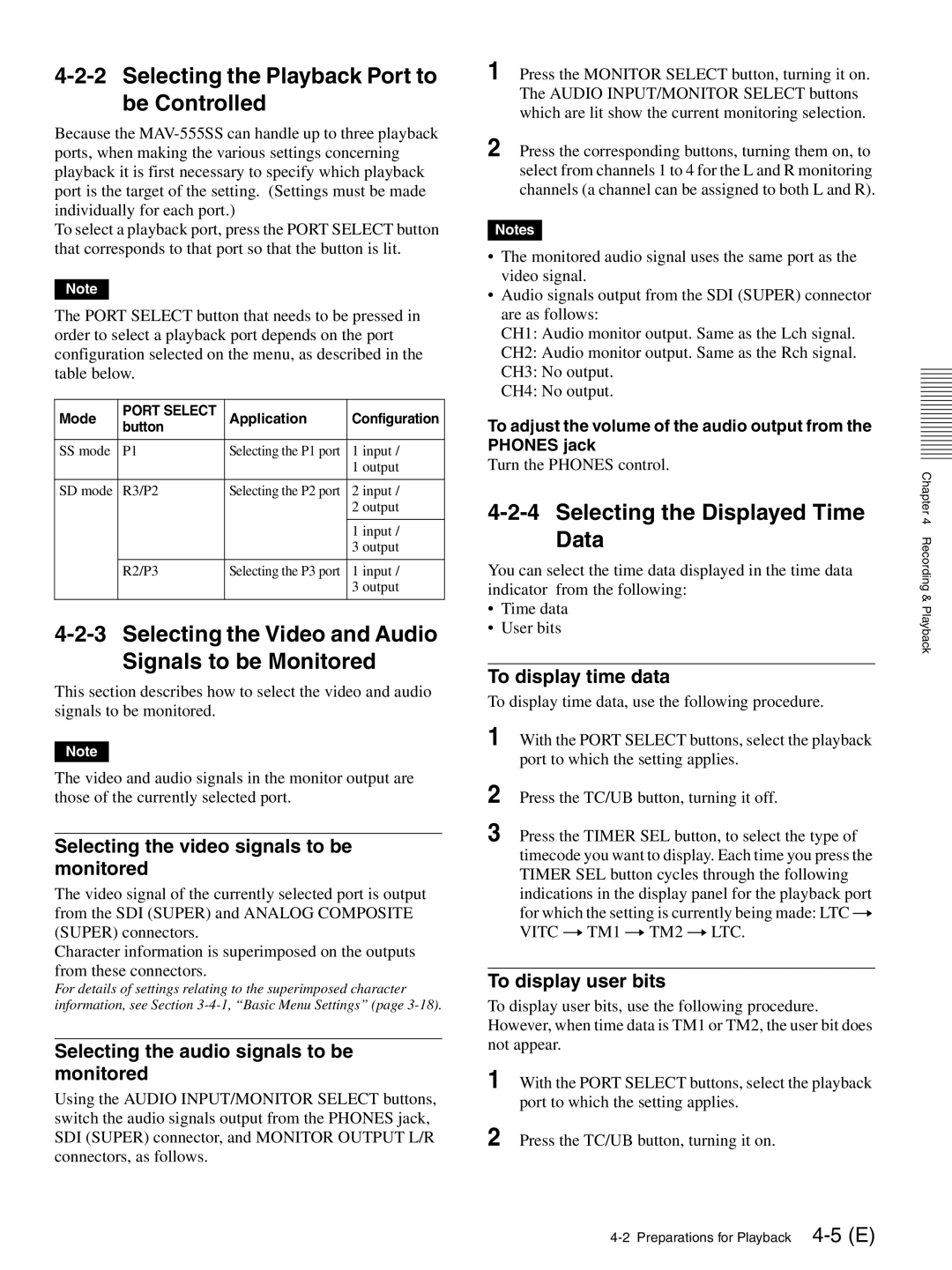
4-2-2 Selecting the Playback Port to be Controlled
Because the
To select a playback port, press the PORT SELECT button that corresponds to that port so that the button is lit.
Note
The PORT SELECT button that needs to be pressed in order to select a playback port depends on the port configuration selected on the menu, as described in the table below.
Mode | PORT SELECT | Application | Configuration |
| button |
|
|
SS mode | P1 | Selecting the P1 port | 1 input / |
|
|
| 1 output |
|
|
|
|
SD mode | R3/P2 | Selecting the P2 port | 2 input / |
|
|
| 2 output |
|
|
|
|
|
|
| 1 input / |
|
|
| 3 output |
|
|
|
|
| R2/P3 | Selecting the P3 port | 1 input / |
|
|
| 3 output |
|
|
|
|
4-2-3 Selecting the Video and Audio Signals to be Monitored
This section describes how to select the video and audio signals to be monitored.
Note
The video and audio signals in the monitor output are those of the currently selected port.
Selecting the video signals to be monitored
The video signal of the currently selected port is output from the SDI (SUPER) and ANALOG COMPOSITE (SUPER) connectors.
Character information is superimposed on the outputs from these connectors.
For details of settings relating to the superimposed character information, see Section
Selecting the audio signals to be monitored
Using the AUDIO INPUT/MONITOR SELECT buttons, switch the audio signals output from the PHONES jack, SDI (SUPER) connector, and MONITOR OUTPUT L/R connectors, as follows.
1 Press the MONITOR SELECT button, turning it on. The AUDIO INPUT/MONITOR SELECT buttons which are lit show the current monitoring selection.
2 Press the corresponding buttons, turning them on, to select from channels 1 to 4 for the L and R monitoring channels (a channel can be assigned to both L and R).
Notes
•The monitored audio signal uses the same port as the video signal.
•Audio signals output from the SDI (SUPER) connector are as follows:
CH1: Audio monitor output. Same as the Lch signal.
CH2: Audio monitor output. Same as the Rch signal.
CH3: No output.
CH4: No output.
To adjust the volume of the audio output from the PHONES jack
Turn the PHONES control.
4-2-4 Selecting the Displayed Time Data
You can select the time data displayed in the time data indicator from the following:
•Time data
•User bits
To display time data
To display time data, use the following procedure.
1 With the PORT SELECT buttons, select the playback port to which the setting applies.
2 Press the TC/UB button, turning it off.
3 Press the TIMER SEL button, to select the type of timecode you want to display. Each time you press the TIMER SEL button cycles through the following indications in the display panel for the playback port for which the setting is currently being made: LTC t VITC t TM1 t TM2 t LTC.
To display user bits
To display user bits, use the following procedure. However, when time data is TM1 or TM2, the user bit does not appear.
1 With the PORT SELECT buttons, select the playback port to which the setting applies.
2 Press the TC/UB button, turning it on.
Chapter 4 Recording & Playback
